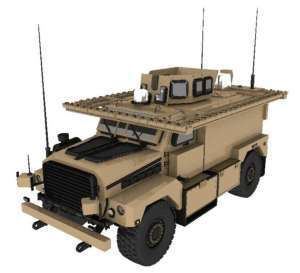Place of origin United States | Designer Artis | |
 | ||
Iron Curtain is an active protection system (APS) designed by Artis, an American technology development and manufacturing firm headquartered in Herndon, Virginia. The system is designed to protect military vehicles and other assets by intercepting threats such as rocket-propelled grenades and rendering them inert.
Contents
Technology
The system, which began in 2005 as a DARPA program, is able to defeat threats even if fired from an extremely close range.
Iron Curtain uses C-band radar, a distributed optical sensor, and a ring of ballistic countermeasures to neutralize incoming threats. First the radar detects and tracks the incoming round and alerts the system. It then switches from armed-ready state to an armed state. As the round comes into close range, the optical sensor profiles the threat and tracks it within 1 cm (0.39 in) of accuracy to select an aimpoint and determine which ballistic countermeasure to fire. The countermeasure fires straight down or up, neutralizing the incoming threat within inches of the vehicle, separating the system from many others which intercept threats several meters out, resulting in minimal risk of collateral damage to dismounted troops or civilians. The countermeasure deflagrates the RPG warhead without detonating it, leaving the dudded round to bounce off the vehicles side.
Because of its shelf-like design, the system can be modified to protect almost any surface, from the sides of the vehicle to all around protection, including the top. Artis claims that the Iron Curtain can be enhanced to protect against “more challenging threats” like the RPG-29 and RPG-32 ‘Hashim’ multipurpose anti-tank grenade launchers, which utilize tandem warheads for penetrating tanks with explosive reactive armor. Iron Curtain should also be able to defend against ATGMs (Anti-Tank Guided Missiles). The system has 360° coverage, is multi-shot, low-cost, low power, lightweight, and rugged and reliable.
The system’s radar was developed by Mustang Technology Group in Plano, Texas. Iron Curtain has undergone significant safety testing, including temperature and shock testing, and its software architecture has been approved by the U.S. military's Joint Services Weapons Safety Review Board.
In August 2016, the U.S. government approved Artis to test the RPS-10 radar, built by RADA Electronic Industries, with Iron Curtain.
Government testing
In 2016, the U.S. Army began an expedited effort to install and characterize several APSs, including Iron Curtain, in preparation for further decisions in the summer of 2017.
In April 2013, the company announced it achieved a perfect score during rigorous government tests. “We proved not only that Iron Curtain defeats threats and saves lives, but the risk from collateral damage is minimal, especially when compared with the alternative," according to the company's CEO, Keith Brendley. He said the system is ready to be deployed onto battlefields.
Vehicles Integrated
The system has been integrated onto three ground vehicles: the Army's Ground Combat Vehicle built by BAE Systems, the MATV built by Oshkosh Defense, and the Humvee built by AM General. In addition, General Dynamics Land Systems designed the system for integration onto its LAV III.
